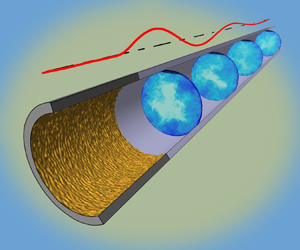Article contents
Turbulent pipe flow response to a step change in surface roughness
Published online by Cambridge University Press: 15 October 2020
Abstract

The long-lasting response of turbulent pipe flow to a step change in surface roughness from rough to smooth is examined. Global flow characteristics such as the pressure gradient, skin friction and mean streamwise momentum attain their equilibrium values within approximately 20 radii downstream of the step change, but the turbulent stresses are exceedingly slow to adjust to the new wall condition ( ${>}120\ \textrm {radii}$), and they first fall below their equilibrium values before seemingly asymptoting to the full recovery state. To help understand this response, we develop a model that captures both the long development length and the second-order response of the turbulence, and we use a scale decomposition to connect the large-scale motions to the response behaviour.
${>}120\ \textrm {radii}$), and they first fall below their equilibrium values before seemingly asymptoting to the full recovery state. To help understand this response, we develop a model that captures both the long development length and the second-order response of the turbulence, and we use a scale decomposition to connect the large-scale motions to the response behaviour.
JFM classification
- Type
- JFM Papers
- Information
- Copyright
- © The Author(s), 2020. Published by Cambridge University Press
References
REFERENCES
- 9
- Cited by





